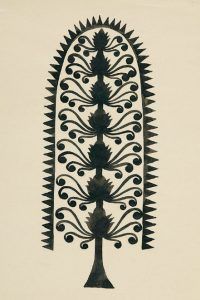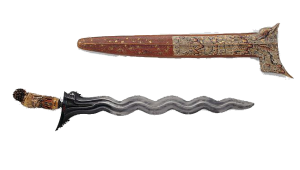IO – On the 25th of October 2017 the Fascinating Indonesia Room was launched at the Hofburg Palace in Vienna in its Weltmuseum or World Museum. Th creation and establishment of the Room was only possible through the generous patronage of well-known Indonesian collector and patron of the arts, Budi Mranata. “I saw that the Austrian Weltmuseum had a very valuable Indonesia collection including a Raden Saleh painting which is now the showpiece of the collection which I felt should be on display. Austria is home to several big international organizations and the Hofburg is visited by many tourists every year. What was foremost in my decision to sponsor the Indonesia room was that I felt that by doing so I would also be promoting Indonesia and especially Indonesian culture.”

Arief Yahya, Indonesian Minister for Tourism who was a former classmate of Pak Budi in Banyuwangi, East Java is in agreement. He feels the Room will also help promote tourism to Indonesia When Pak Budi asked his opinion about Pak Budi sponsoring the room he was very supportive and immediately said, “Excellent I shall send a message to Indonesia’s ambassador in Vienna to take note and support your initiative.”
“Our ambassador has already brought both members of the MPR or People’s Consultative Assembly as well as members of Indonesia’s House of Representatives or parliament when they visited Vienna to the museum to see the Fascinating Indonesia Room. You know, Indonesia already caught the attention of the world centuries ago. People have been collecting Indonesian cultural artifacts for hundreds of years,” remarked Pak Budi.

In that Pak Budi is certainly correct. Habsburg Archduke Franz Ferdinand already visited Indonesia during his tour around the world between 1892 and 1893. “He visited places such as West Java, Borneo and the Moluccas. While he was in the Moluccas he met Baron van Höevell who was the Resident of Ambon at the time and who gave his collection of 900 Moluccan artifacts to the Duke who brought them back to Vienna where they were carefully documented. There were all sorts of things ranging from necklaces and spoons to a flag of the island of Babar. He also brought back batiks, wayang and krises” commented a former curator of the Fascinating Indonesia Room, Jani Kuhnt-Saptodewo.

The Weltmuseum Wien now holds an extremely valuable collection of 1,200 ethnographic objects from the Moluccas alone which complement the artifacts held by the Museum Siwalima in Ambon. Together the two museums tell a more complete story of the culture and history of the Moluccas. For example, historic pieces of basketwork are rare at the museum in Ambon because such organic material could not be easily preserved in a tropical climate. At the Weltmuseum there are many well-preserved basketwork pieces from the Moluccas. The two museums have therefore been working together on indexing and researching a conjoint heritage of ethnographical objects.
Jani Kuhnt-Saptodewo is a Javanese lady from Solo who after graduating in German literature at the University of Indonesia then continued studying Indonesian ethnology at the Munich Stadtmuseum and after carrying out fieldwork with regard to religion amongst the Dayaks of Kalimantan she wrote her thesis and produced a film which received an award from the American Anthropological Association. She later became a curator at the Weltmuseum Wien.

Ibu Jani explains, “One of the most important pieces of the collection in the Indonesia room is a large painting by Raden Saleh of tigers fighting each other. Raden Saleh was able to get his painting to the Austrian Emperor through the help of a nobleman in Dresden. The painting was then placed in storage and this is the first time that it has been on public display since 1870.”
Raden Saleh was apparently good at marketing for in 1870 he sent one painting of his to Franz Josef I, the Emperor of Austria and one each to the Emperor of Russia and Emperor Wilhelm I of Germany. The one intended for Napoleon III was never sent and remains in Bogor as he was deposed before it could be sent.
“There were two people who donated important Indonesian collections to the museum namely Johann Schild and Helene Potjewijd.

Schild came from a wealthy family near Vienna and went to Sumatra as the representative of a Dutch trading company. His family had a business in colonial products such as tobacco so he was interested in all sorts of products and specimens of both Indonesian culture as well as nature. By way of example he sent many specimens of flora and fauna to the Natural History Museum in Vienna.”
The 1870s was the time when Japan was first opened to the West and Vienna held its great World Exposition in 1873. So, it was a time when many people in Europe became very interested in Asia especially Japan. Ibu Jani noted that Schild was in Sumatra from 1890 until the 1920s with several trips back to Austria when he would always make donations to the museum. When he finally returned to Austria for good he donated an enormous collection of artifacts mostly from Sumatra, Nias and also the Mentawai islands. He later became the honorary German Consul and also the honorary Austrian Consul in Padang. During the First World War the famous German warship the Emden which despite sinking much Allied shipping was very popular even with the Allies (its captain always allowed crews and passengers to leave their ships before sinking them)
came to Padang Harbour for repairs. As Holland was neutral during the First World War it was forbidden to assist the Emden. “Nevertheless, Schild as German Consul managed to help the Emden obtain repairs and provided money and food for its crew. He became quite a hero thereafter in certain quarters,” observed Ibu Jani.

Another important collector who donated Indonesian objects to the museum was Helene Potjewijd. Her father, Theodor Hirsch was Austrian and owned a tobacco plantation in Indonesia whereas her mother was a Chinese Indonesian peranakan or mixed blood lady. Helene who was born in Meester Cornelis, Batavia married a man called Andreas Potjewijd who later became the manager of the Hotel Bali in Denpasar from1928 till
1930. Mrs Potjewijd ran the tourist shop in the hotel and became friends with artists such as Walter Spies and the famous Balinese artist Lempad. “Can you imagine, I found several Walter Spies graphic drawings in a drawer of the Museum?” declared Ibu Jani with a delighted laugh.

He produced over 500 lamak paintings of which 44 are part of the Museum’s Indonesia collection. (photo: Khm-Museumsverband Doc.)
The drawings are of lamak motifs namely designs of the intricate decorations made daily of coconut fronds for shrines and offerings. Apparently, Walter Spies was amazed and distressed that objects of such high artistic and cultural value were simply thrown away every two days. So, he went from village to village making graphic style drawings of the many
different designs and motifs of lamak. “He probably made around 500 such drawings and I found 44 of them here at the museum donated by Mrs Potjewijd. The rest were thought to have disappeared but then more and more started to turn up in the Netherlands, in America and other places. So, now there are about 200 lamak drawings by Walter Spies known to still be in existence from the original over 500 lamak drawings that he is said to have made,” confided Ibu Juni happily.

There are also paintings by Lempad. There is one in colour which is unusual and also a very large black and white painting. “Helene in fact wrote a book of Balinese stories with drawings by Lempad showing the influence of Jugendstil or Art Nouveau. She brought the manuscript and drawings back with her when she moved to Vienna in 1936 because she was afraid war would break out. She gave the book to a publisher in Vienna for publication but unfortunately it was lost during the War and she herself died in 1946,”
Beside the many ethnographical artifacts in the Indonesia collection there are also a number of batiks in the Indonesia collection.

Ibu Jani originally comes from Solo and her grandmother was a very skilled batik maker who used natural dyes and understood the traditional rules about batik designs as well as their history. So, she was of course very interested in the collection. It has some very nice pieces including a batik made by the most famous producer of Batik Belanda or batik that shows European influences namely, Eliza van Zuylen and also one by the most famous of the Chinese batik producers the legendary Oey Soe Tjoen of Pekalongan in East Java. The oldest batik in the collection is from 1855 and was brought back on the Austrian Novara Expedition.

The Novara expedition was the first scientific round the world expedition carried out by the Austro-Hungarian navy. It lasted from 1857 till 1859 and was authorized by Archduke Maximilian during the reign of Emperor Franz Josef I. The expedition was carried out by the frigat.
Novara with Archduke Maximilian who was Franz Josef’s younger brother, aboard the ship. Indonesia was among the many countries it visited and many items were also brought back from Indonesia. Some years later the ship was to take Archduke Maximilian to Santa Cruz in Mexico where he became Emperor of Mexico. Sadly, it was also this ship which brought his body back to Austria after he was executed in Mexico.
The Hofburg Imperial Palace where the Weltmuseum with its Fascinating Indonesia Room is located is a collection of buildings built from the 13th till the 19th century displaying a dazzling variety of styles from early Gothic to Art Nouveau. It was originally the residence and court of the Habsburg dynasty, the Holy Roman Empire and sovereigns of the Austro-Hungarian Empire. The House of Habsburg was one of the most distinguished and influential royal houses in Europe. Now the Hofburg Palace is the official residence and office of the President of Austria.

The Weltmuseum which was established in 1876 is an anthropological museum which houses over 400,000 objects from Asia, Oceania, Africa and America. It was originally the Anthropological-Ethnographic Department of the Imperial and Royal Court Museum of Natural History. This together with the Archduke Franz Ferdinand’s collection, which comprised more than 14,000 objects and around 1,100 photographs became the Museum of Ethnology in 1928 in the Hofburg. It was only in 2013 that it was renamed the Weltmuseum Wien. As part of the agreement with Budi Mranata who sponsored the creation of the Fascinating Indonesia Room, the room will be used to exhibit Indonesian artifacts for the next thirty years. The Austrian Commercial Counselor in Jakarta, Clemens Machal commented that, “It is a very unique collection and the Fascinating Indonesia Room helps to bring Indonesian cultural traditions to Austria and is good for both Austrian as well as Indonesian tourism.,”

When asked if Budi Mranata might receive some sort of recognition from the Austrian government for his contribution, he replied, “Anything is possible but there would have to be a request for that and of course, it would have to be approved by the Austrian government.”
Since Indonesia also benefits from the Fascinating Indonesia Room perhaps Pak Budi should also receive some recognition for his generosity and unfailing support for Indonesian culture from the Indonesian government.
(Tamalia Alisjahbana)
If you enjoyed reading this article you may also enjoy Part II of the article by the same writer:
https://observerid.com/collectormania-the-world-over-from-the-habsburgs-to-indonesian-collector-boedi-mranata/

